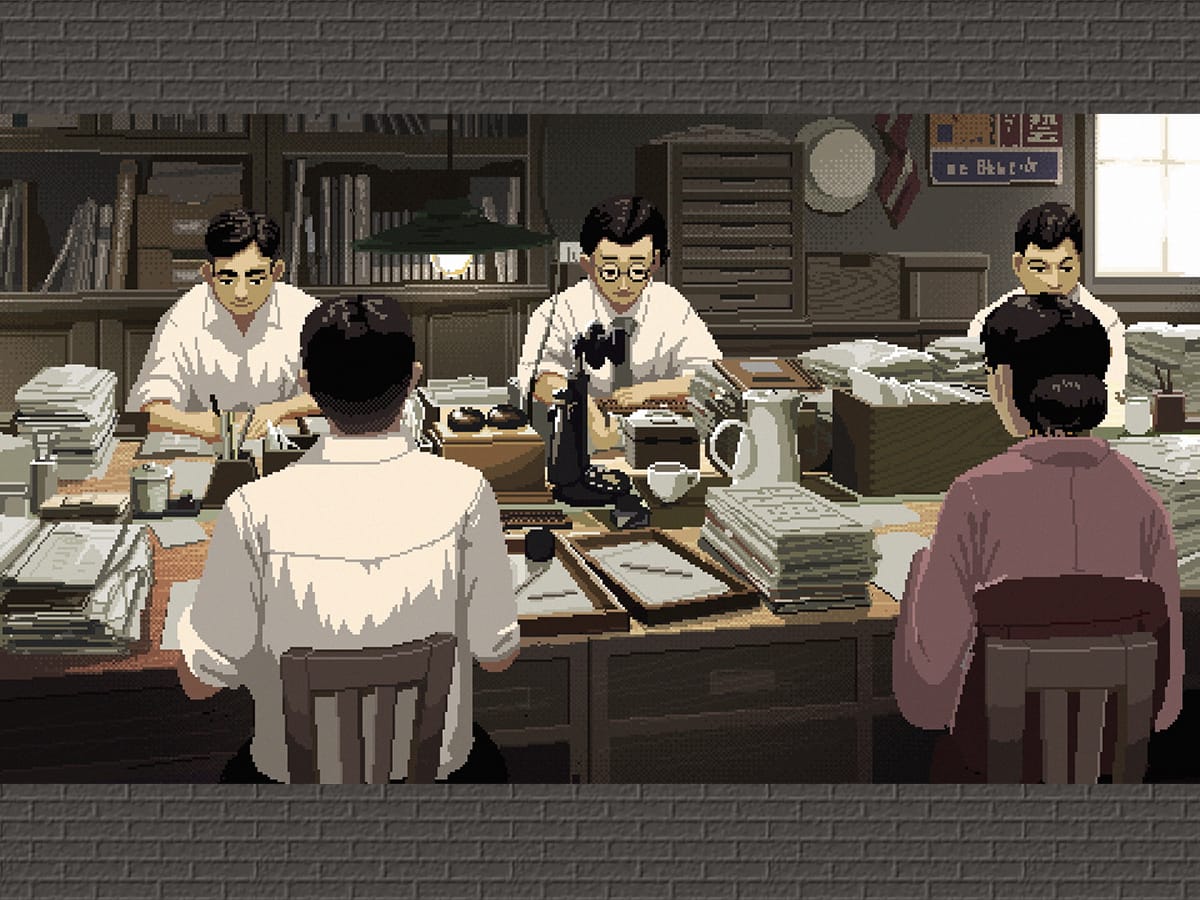
Source: © PR Times, Inc.
SmartHR’s emotional anime traces a century of work in Japan with pixel art by Motocross Saito
- Tags:
- Animation / Business / century / Japanese history / labor history / Motocross Saito / pixel art / Salaryman / SmartHR / Work
Related Article
-

Interview with Dimension Girl and Metro Mew character designer HYPERSPACE
-

Kuge: Japan’s original art snobs have a lot to answer for
-

SpongeBob SquarePants As An Anime Is Pretty Dramatic
-

830,000 people want to know where this door goes
-

Japanese construction company has clever and touching welcome to new recruits
-

Touching Flip Book Animation Is Making Teary-Eyed Audiences Miss Their Moms


"100 YEARS OF WORK in JAPAN"
On August 18th, 2021, SmartHR Co., Ltd., a Japanese company specializing in HR cloud software, released a new company branding video entitled "100 YEARS OF WORK in JAPAN." The two-minute video traces the changes in Japanese white-collar work and work culture over the course of a century from the 1920s, when the word サラリーマン sararīman was popularized, to the 2020s.
It is created entirely in pixel GIF animation by the talented Motocross Saito, whose moody and memorable animations we have featured before in grape Japan, and paired with an emotional soundtrack by musician, model and actor HIMI, the son of popular Japanese singer Chara and internationally famous actor Tadanobu Asano. The film is directed by So Otsuki and supervised by Prof. Katsu Hara, an expert in modern Japanese labor history who consulted on the detailed manner, remarkable for a pixel GIF animation, in which each vignette of Japanese history was portrayed.
"100 YEARS OF WORK in JAPAN" was created as part of SmartHR's 働くの実験室(仮)(meaning "laboratory for work [tentative title]") a project designed to promote discussion within society on how people should work and what companies should be like in the future.
Let's take a look at the video and the remarkable details which bring each historical vignette to life:
Video
1920s: Birth of the Sararīman
About 100 years ago in the 1920s, a new word with a modern-sounding ring to it was born in Japan: sararīman. After World War I ended in 1919, the industrial landscape rapidly changed around the world. In Japan, as in other countries, white-collar work flourished as more people worked in offices. In those days, offices had wooden desks and chairs, and even telephones were made of wood. In an interesting detail specific to Japan, men wore Western-style clothes while women wore traditional Japanese clothes.
1930s: The Rise of the Working Woman
The rapid economic development after World War I led to the creation of many new jobs that had never been seen before, especially in urban areas, and the number of female workers increased. One of the occupations in which women were active was as telephone switchboard operators. The job required politeness, understanding and tact. As the demand for telephones increased, telephone exchanges became larger, both horizontally and vertically, and some switchboard operators had to wear high-heeled clogs to reach the upper row of connections. This occupation existed until the late 1970s, when domestic telephone switching was fully automated.
Early 1940s: Work During the War
During the Pacific War, people continued to work at companies despite the harsh environment. Since supplies were scarce, clothing had to be simplified. Therefore, the government enacted the "National Dress Code." The khaki-colored 国民服 kokuminfuku (national uniform) became the standard dress for men. Two years after the National Dress Code was enacted, a traditional working outfit based on loose-fitting pants known as もんぺmonpe was designated as the standard dress for women. However, some people resisted this legislation and continued to wear suits, so in urban areas, commuters could be seen going to work in a variety of styles, including suits, one-piece dresses, kokuminfuku and monpe. A sign in the background carries a government slogan: "luxury is the enemy."
Late 1940s to Early 1950s: From War to Peace
The scene portraying people going to work during the war is followed by a focus on workers' feet. A man wearing puttees, cloth leg bindings used by soldiers to protect their shins, walks on the road in the late 1940s while the next scene shows a worker in the early 1950s. The roads are now paved and men no longer wear kokuminfuku. However, the business slacks of that time were characterized by a thicker overall design compared to what we see today. Also, leather shoes became the standard fashion at this time. In 1947, immediately after the end of the war, the Labor Standards Law was enacted to protect workers by setting minimum standards for wages, working hours, vacations, and other working conditions.
1950s: Lifetime Employment and the Seniority System Take Root
Japan in the 1950s was slowly recovering from the post-war turmoil and entering a period of rapid economic growth. In this scene, we can see a midsummer office scene in an architectural firm. An employee is sweating and working hard on a sales call in a sales office with no air conditioning. The man is surrounded by a pile of papers, a black telephone, an abacus, and his coworker has a cigarette still lit on his desk. Hanging in the background are helmets of the type used at construction sites at the time.
It was during this period that the lifetime employment system, which includes long-term employment of workers, promotion based on seniority, and retirement benefits, took root in Japanese society.
1960s: Tokyo to Osaka Day Trips Become Possible
Japan was at the peak of its rapid economic growth in the 1960s. The Tokaido Shinkansen (bullet train) line opened in time for the Tokyo Olympics, cutting down travel time from 12 hours round-trip to 8 hours, making it possible to make day trips between Tokyo and Osaka. The men in this scene are relaxing in a train bound for Osaka, and beyond the window is a summer view of Mt. Fuji. The Apollo moon landing of July 1969 is on the front page of the newspaper in the foreground.
1970s: Shinjuku Station During the Morning Commute
By the 1970s, the number of people living in Tokyo had increased dramatically, and the population, which was about 3.5 million in 1945, grew to over 11 million. In the last 50 years, Tokyo's commuter rush has gotten worse, with some lines carrying more than 300% of its passenger capacity. However, things were even worse in the 1970s, with commuter trains being likened to "killer trains" and commuting to work as "commuter hell. Station attendants often had to push passengers in. As you can also see in this scene, many men had similar hairstyles and clothes.
1980s: Late-Night Office Work and Workaholic Employees
An office in the 1980s. The clock shows that it's past 2 a.m. but some employees are still working, while others are sleeping. At this time of night, the trains have stopped running, and taking a cab home is too expensive for most employees. This was also the time when many catchphrases were coined to describe people working long hours, such as 企業戦士 kigyō senshi (corporate warrior), モーレツ社員 mōretsu sha'in (hard-driving or workaholic employee) and 24時間働けますか? nijūyojikan hatarakemasu ka ("Can you work 24 hours a day?") from a popular energy drink commercial. If you look closely, you'll see that the man is using an electronic word processor, a sign of the changing times.
1980s: Friday Night in the Heyday of the Economic Bubble
This depicts a city at night in the midst of the bubble economy. In those days, it was common for sararīmen to go out at night to entertain clients and have 飲み二ケーション nominication (a portmanteau of 飲む nomu, meaning "to drink", and communication) with their colleagues and bosses. Late at night, people lined the streets in downtown areas, trying to hail cabs.
In the foreground at left, two women are dressed in ボディコン bodycon (body-conscious) form-hugging one-piece dresses and ワンレン wanren (one-length haircuts) which were fashionable at the time. The woman on the right holds a huge cell phone. This was the beginning of cell phone culture. When they were first released, they were very expensive, and having one was a status symbol. It was also around this time that the term 花金 hanakin (literally, "flowery Friday") was born, referring to having fun and drinking on Friday nights. Hanakin was a time when the streets were filled with people and the city was lively until dawn.
1990s: Getting Notified by Pager
The pager, nicknamed ポケベル pokeberu (literally "pocket bell") in Japan, was originally a simple device that notified the user of incoming calls with a sound and allowed the user to call back from a public phone. As more functions were added and the screen became larger, it became possible to display letters and numbers, and sending and receiving messages became popular. The pager in this scene says: "Call me." The number of pager subscribers surpassed 10 million in 1996. In the business scene, it was used by employees in the office to communicate with sales representatives out on assignments.
1990s: An Increasingly Digital Office
Offices with piles of paper have given way to desktop computers and company cell phones are distributed to employees. At the same time, with the revision of the Equal Employment Opportunity Law, women became more active participants in society. In this scene, we see a female employee, wearing a suit with big shoulder pads as were still fashionable in the early 1990s, asking her male boss to stamp a document with a hanko seal. Even though offices were becoming more digital, there were still many tasks requiring paper, and plenty of faxes (...even today).
2010s: Digital Nomads
With the introduction of public wireless LANs and high-speed mobile data communications, as well as flexible work styles, it became possible to work in cafes, rental offices, and places other than a permanent office. In 2019, the Workplace Reform Act came into effect, making it compulsory for companies to allow employees to take annual paid leave and imposing a cap on overtime work in order to cope with the decline in the working-age population and the diversification of work styles.
2010s: Smartphone Communication
Since the 2000s, communication in the business world became dominated by phone calls and emails. In the 2010s, as smartphones and communication apps became more common, business messaging apps and chat apps began to be used at work. These applications are still being actively used as a means of speedy communication regardless of location or environment.
2020s: Office Work During the Novel Coronavirus Pandemic
The novel coronavirus pandemic that began in early 2020 has rapidly changed the way people work. In this scene, we can see many innovations to prevent infection in the office, such as wearing masks, keeping disinfectant sprays on desks, and clear partitions separating employees. Also, there are fewer documents around the desk, indicating a more digital office.
The pandemic has also accelerated the movement to eliminate the use of physical hanko seals in business processes and to promote paperless work. Interest in improving business efficiency, which had been growing due to the implementation of the Workplace Reform Act, also increased dramatically. More and more companies are taking this opportunity to rethink the way they work, rather than just taking temporary measures.
2020s: The New Normal at Work
The final scene depicts the spread of telework as a result of the novel coronavirus pandemic. These days, it's not unusual to work from home using video conferencing and chat tools.
In this scene, a man is holding his small child next to a woman who is having a video conference in the living room. As more and more people work from home, it's not uncommon to hear the voices of children and pets during video conferences, bringing the distance between work and domestic life much closer. In June 2021, the revised Child Care and Family Care Leave Law was enacted, encouraging more men to take childcare leave.
So, what's coming next?
For more information on SmartHR, visit their website here.